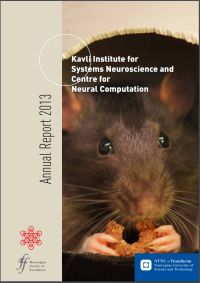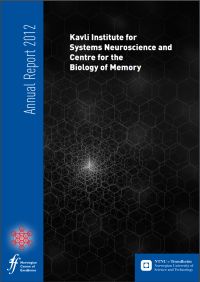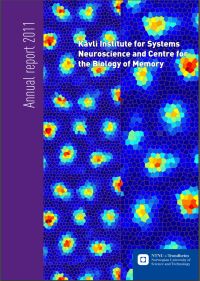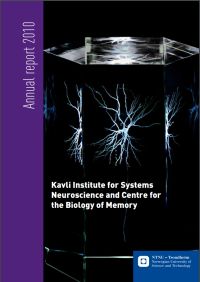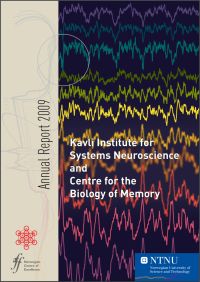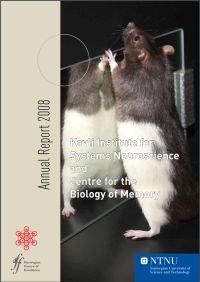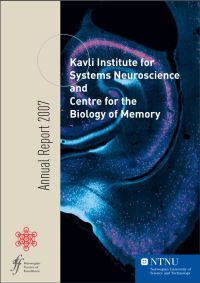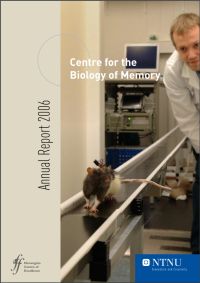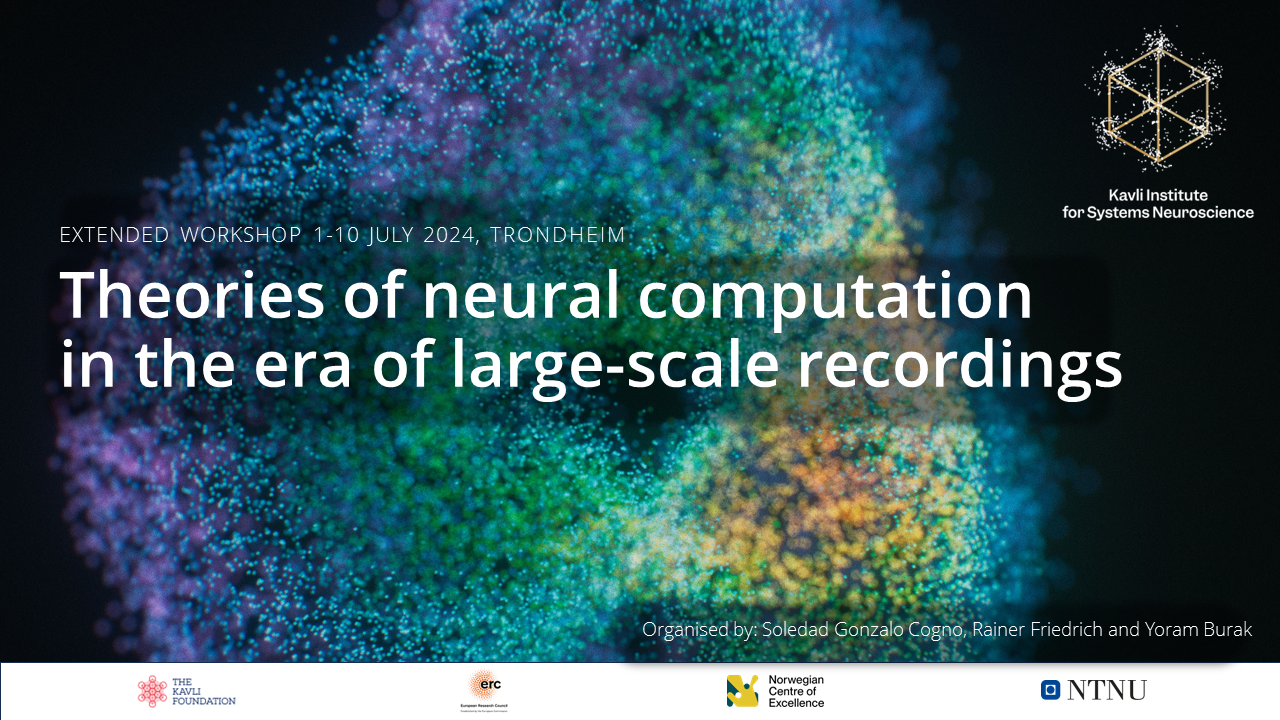Interneuron Networks Control Distinct Elements Of The Brain's Positioning System
Outreach
Brain Science Discoveries at KISN
Say hello to Mini2P - the brain explorer!
Mini2P is an open-source miniature 2-photon microscope brain explorer for fast high-resolution calcium imaging in freely-moving mice.
Get to know Mini2P.
A framework in your brain for organising the order of things

Scientists at NTNU’s Kavli Institute for Systems Neuroscience have discovered a pattern of activity in the brain that serves as a template for building sequential experiences.
A framework in your brain for organising the order of things (Norwegian SciTech News).
Minute-scale oscillatory sequences in medial entorhinal cortex (Nature)
Annual Report
Earlier annual reports
Stories from KISN
Interneuron Networks Control Distinct Elements Of The Brain's Positioning System
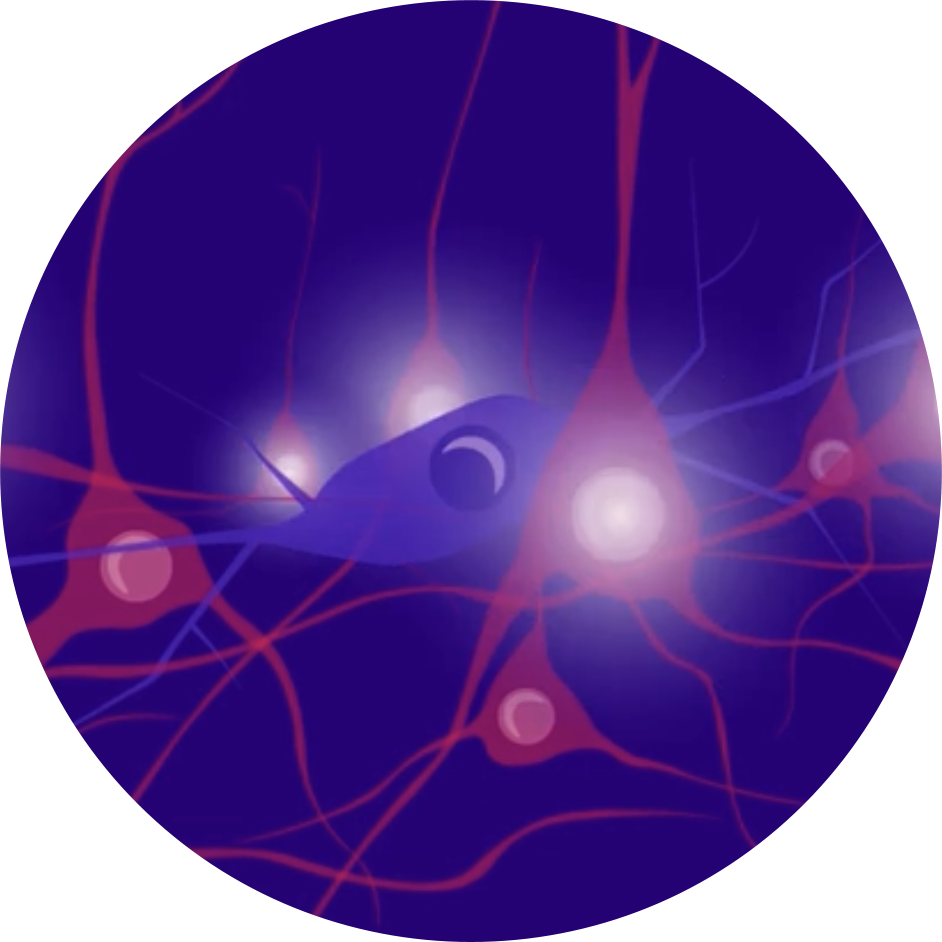
Navigating the busy city streets, do you ever reflect on how your brain is able to guide you in the right direction? Deep inside your brain, scientists have found a neural network continuously measuring and calculating your body’s movements and position in your surroundings, dynamically updating its calculations according to the passing landscape.
Scientists have until recently not known much about the specific circuits and mechanisms that allow for the precise control of self-positioning in this network. Recently, a group of scientists at the Kavli Institute for Systems Neuroscience in Trondheim, set out to uncover the neurons that shape and regulate large scale activity in this network. They identified two distinct classes of interneurons that orchestrate independent cell classes of the positioning system.
THE BRAIN’S GPS
Unravelling how this neural circuit works, begins with understanding its component parts and the roles they play in navigation and memory. The brain’s headquarters for self-positioning sits in an area called the medial entorhinal cortex. Scientists have discovered a collection of specialized cell types in this area that are receptive to different features of your local space, like distances and borders.
 Fig. 1 - Highlighted in green is the brain’s headquarters for self-positioning, the medial entorhinal cortex, situated right in front of the hippocampus, in pink. Both structures are located in the temporal lobes of the brain.
Fig. 1 - Highlighted in green is the brain’s headquarters for self-positioning, the medial entorhinal cortex, situated right in front of the hippocampus, in pink. Both structures are located in the temporal lobes of the brain.The first cell type to be discovered back in 2005 was the grid cell. Grid cells are neurons that provide your brain with a GPS-like function and produce a metric for space. Grid cells use your own motion to map your location in the environment. By firing at fixed locations in the environment, each cell produces a regular hexagonal pattern that tiles the available space. In order to calculate position from movement, grid cells need information about speed. Speed cells measure your running speed through the environment. Another type of neurons, border cells, express your proximity to geometric borders in the landscape. Head direction cells track your orientation relative to landmarks in your environment. Researchers have also observed cells that respond to location but do not form a grid pattern. These cells are known as aperiodic cells.
– Grid cells need to be connected to other grid cells with similar firing pattern in order to provide the brain with exact data for localization and self-orientation, explains Edvard Moser. – The periodic nature of the grid pattern suggests a high level of coordination across functionally connected ensembles of grid cells. However, most grid cells in the medial entorhinal layer II area (MEC II) only connect to and communicate via interneurons, says Moser.
This led the researchers Miao, Cao, Moser and Moser to ask whether these interneurons could play an essential role in the production of the stable spatial grid pattern.
INTERNEURONS - GATEKEEPERS OF NEURAL CIRCUITS
The two most common categories of neurons in the brain are excitatory and inhibitory neurons. Grid cells and other neurons sensitive to features of space are all excitatory neurons. Interneurons, providing connectional pathways between ensembles of neurons, are inhibitory. They are often thought of as the breaks of the brain. When an interneuron is active, it usually inhibits activity in the excitatory neurons that it connects to. When interneurons are quiet, excitatory neurons fire.
 Fig. 2 - The blue interneuron is active and thus inhibits activity in the excitatory neurons (red) that it connects to.
Fig. 2 - The blue interneuron is active and thus inhibits activity in the excitatory neurons (red) that it connects to.
 Fig. 3 - When interneurons (blue) are quiet, excitatory neurons (red) are active.
Fig. 3 - When interneurons (blue) are quiet, excitatory neurons (red) are active.
OPERATING BY SWITCH OR FILTER
There are two major classes of interneurons in the medial entorhinal cortex: those that contain parvalbumin and those that contain somatostatin. These two classes of interneurons bind differently to ensembles of excitatory space cells. Parvalbumin (PV) interneurons bind synaptically directly to the soma of their goal cells, providing a switch-like function for directly turning on or off the activity of the excitatory cells they regulate. Somatostatin (SOM) interneurons, by contrast, bind to the dendrites of their goal cells, selectively gating excitatory input signals from different sources, thereby changing by arithmetic their relative contributions to the output of the excitatory goal cell.
 Fig. 4 - PV interneurons (blue, left) bind to the soma of their goal cells (red), providing a switch-like function. SOM interneurons (blue, right) bind to the dendrites of their goal cells (red), filtering their input signals.
Fig. 4 - PV interneurons (blue, left) bind to the soma of their goal cells (red), providing a switch-like function. SOM interneurons (blue, right) bind to the dendrites of their goal cells (red), filtering their input signals.THE EXPERIMENT
The group of researchers at Kavli Institute for Systems Neuroscience wanted to find out how the inhibitory interneurons of the parvalbumin and somatostatin groups exert control over the circuit of spatial cells in the medial entorhinal cortex. To test this, they set up an experiment measuring activity from the various space-modulated, excitatory cell types in freely behaving mice.
In the baseline state, before any intervention, all excitatory cells responded to spatial features in their normal manner: Signals from the grid cell formed a hexagonal pattern covering the surface of the box, while spikes from the aperiodic cell drew up one or several larger fields with no particular pattern.
 Fig. 5 - The control of the experiment. When both types of interneurons operate normally, all excitatory cells respond accurately to the mouses spatial surroundings.
Fig. 5 - The control of the experiment. When both types of interneurons operate normally, all excitatory cells respond accurately to the mouses spatial surroundings.The researchers then used a pharmacogenetics tool to selectively silence the activity of either parvalbumin (PV) or somatostatin (SOM) interneurons. To target the two subgroups selectively, they used two groups of PV-Cre and SOM-Cre transgenic mice. A Cre-dependent AAV virus was injected into the medial entorhinal cortex of each group. This virus carried the gene for an artificial receptor, a DREADD. The Cre dependence ensured that the receptor was expressed exclusively in parvalbumin (PV) or somatostatin (SOM) interneurons, depending on the mouse line. When the drug CNO was introduced into the body, it bound to the DREADD receptors only, and caused selective silencing of either parvalbumin (PV) or somatostatin (SOM) cells for a period of hours.
 Fig. 6 - The researchers used a pharmacogenetics tool called DREADD to produce an artificial receptor (light blue and Y-shaped) exclusively in either the PV or SOM interneuron. The drug CNO then bound to the artificial receptor only, silencing the activity of said interneuron for a period of < 12 hours.
Fig. 6 - The researchers used a pharmacogenetics tool called DREADD to produce an artificial receptor (light blue and Y-shaped) exclusively in either the PV or SOM interneuron. The drug CNO then bound to the artificial receptor only, silencing the activity of said interneuron for a period of < 12 hours.Silencing the parvalbumin (PV) interneuron altered the grid cells´ behaviour, producing random noise that almost concealed the hexagonal grid signal. The signal from speed cells was also reduced, while aperiodic cells remained unaffected.
 Fig. 7 - Upper left screen:The hexagonally patterned signal from the grid cell under normal conditions. Middle screen: The PV-interneuron is silenced. Upper right screen: When the PV interneuron is silenced, the grid signal is almost concealed in noise.
Fig. 7 - Upper left screen:The hexagonally patterned signal from the grid cell under normal conditions. Middle screen: The PV-interneuron is silenced. Upper right screen: When the PV interneuron is silenced, the grid signal is almost concealed in noise.Silencing the somatostatin (SOM) interneurons, by contrast, did not affect the grid pattern. Instead the firing location of the aperiodic cells became more dispersed and less confined.
 Fig. 8 - Lower left screen:The signal from the aperiodic cell under normal conditions. Middle screen: The SOM-interneuron is silenced. Lower right screen: When the SOM interneuron is silenced, the aperiodic signal is almost concealed in noise.
Fig. 8 - Lower left screen:The signal from the aperiodic cell under normal conditions. Middle screen: The SOM-interneuron is silenced. Lower right screen: When the SOM interneuron is silenced, the aperiodic signal is almost concealed in noise.
CONCLUSIONS
- The experiments reveal that parvalbumin (PV) interneurons interact in a precise manner with grid and speed cells to produce the grid pattern that allows spatial mapping, while somatostatin (SOM) interneurons modulate aperiodic cells, Miao Chenglin explains. - There was no recorded overlap between the two. This suggests that the medial entorhinal cortex is being managed by two distinct interneuronal networks that operate quite independently of each other.
- This was quite a surprise, says Edvard Moser. In other brain regions where parvalbumin and somatostatin interneurons have been investigated, such as the amygdala, they interact quite extensively, so we did not expect them to control distinct cell types so independently.
- The independent modulation of aperiodic cells by somatostatin (SOM) interneurons, points to these excitatory cells as a distinct category of spatially tuned cells, points out Qichen Cao.
Authors: Chenglin Miao, Qichen Cao, May-Britt Moser and Edvard I. Moser
Kavli Institute for Systems Neuroscience and Centre for Neural Computation, NTNU
First published 19 October 2017, by Rita Elmkvist Nilsen
Please contact for more information, images, or for making an appointment for interview:
Rita Elmkvist Nilsen
Head of Communications
Kavli Institute for Systems Neuroscience/
Centre for Neural Computation/
Egil and Pauline Braathen and Fred Kavli Centre for Cortical Microcircuits
NTNU – Norwegian University of Science and Technology
Ph: (+47) 73 59 18 27
Mob: (+47) 907 68 686
E-mail: rita.elmkvist@ntnu.no
Web: https://www.ntnu.edu/kavli
Events
Events at NTNU, Trondheim 5th of Sept. 2024.
KISN Extended workshop
Take a look at the highlights from this summer's workshop: Theories of neural computation in the era of large-scale recordings, 1-10 July in Trondheim by Soledad Gonzalo Cogno, Rainer Friedrich and Yoram Burak.
Thank you to all our wonderful speakers, poster presenters, attendees, & staff for making this event a great success!
National PhD conference in Neuroscience
This year's NRSN conference at the beautiful Jegtvolden Fjordhotell! Don't miss out on the chance to develop your presentation skills, listen to exciting keynote lectures, network with other neuroscientists, and fun social activities ![]()
![]()
Also open for postdocs and MSc students!
![]() Register now by the 20th of August!
Register now by the 20th of August!
Read more on our website.
Selected media
The scientists at the Kavli Institute take part in various activities for communicating science to the public. The tools of the trade for communicating within the science community, like peer-reviewed journals and conference proceedings, are not good sources of knowledge for the public. Rather it’s through popular media, like online video platforms, television, social media, radio, podcasts, newspapers and magazines, as well as popularized talks and debates taking place in the public, that the majority of citizens gain knowledge and advice about science.
Popular science communication demands a translation of both complexity, language and dissemination form, without compromising central scientific aspects. By explaining scientific relationships in a straight-forward language and contextualizing scientific facts within issues of public interest and concern, our scientists aim at not only translating information and facts into publicly accessible knowledge and understanding, but also at providing a vocabulary that allows the broader public to engage in and join discourses about local and global issues that involve both risks and benefits, and in which every citizen is a stakeholder.
These insights represent the fundament for the institute's public outreach activities and science communication plan.
Starmus represents an innovative approach to boosting public understanding of science, inviting citizens to engage with and participate in scientific discourses, by bringing together the very best of science and art into a weeklong popular science dissemination festival. The festival is pulling thousands of visitors, and is covered by major media houses across the world.
In 2016 Edvard Moser participated in the Starmus festival III held in Tenerife, with a popular science lecture on grid cells. Edvard and May-Britt Moser have since been instrumental in bringing the Starmus initiative to Trondheim (2017).
 Popular speakers at the Starmus III festival in Tenerife (2016). Edvard Moser, sixth from left. Photo credits: Max Alexander
Popular speakers at the Starmus III festival in Tenerife (2016). Edvard Moser, sixth from left. Photo credits: Max Alexander"The Grand Narrative" is an animated story about how we find our way in the environment, and why navigation is essential for life.

Into Whiteness is a story of how your ability to find your way in the environment and to remember your history, arise from activity in neural circuits deep within your brain. It is also the story of what happens when these neurons that underpin memory and navigation start dying in Alzheimer’s disease. Learn more about Into Whiteness
New York Times A Sense of Where You Are
Nature Neuroscience: Brains of Norway
Huffington Post The Incredible True Tale Of “The Queen Of Neuroscience” And Her Nobel Prize
Neurosciencestuff A "light switch" in the brain illuminates neural networks
Science Magazine Beam me up, Ratty
Science news Meet 10 scientists who are making their mark
The Guardian How the brain navigates: science Nobel prize special (podcast, 52:20)
Kavli Institute for Systems Neuroscience A journey into the entorhinal cortex (video, 2:51)
Körber Prize May-Britt and Edvard Moser – Winner of the Körber European Science Prize 2014 (video, 9:29)
Skavlan Medicinpriset Maj-Britt och Edvard Moser hos Skavlan (video)
New York Times A Brain's GPS (video, 6:47)
Edvard Moser's Nobel Lecture Grid Cells and the Entorhinal Map of Space
May-Britt Moser's Nobel Lecture Grid Cells, Place Cells and Memory
Grid cells for Young Minds
Frontiers for Young Minds: Can grid cells help us understand the brain?
SUPPORT THE BRAIN RESEARCH
You are most welcome to support the brain research at the Kavli Institute for Systems Neuroscience led by May-Britt Moser and Edvard Moser.
The Research Fund of the Kavli Institute for Systems Neuroscience has the sole purpose of providing direct financial support for the brain research.






